Examining Drivers of Post-Fire Seismic Line Ecotone Regeneration in a Boreal Peatland Environment
Abstract
:1. Introduction
2. Materials and Methods
2.1. Study Area
2.2. Lidar Data Collection and Processing
2.3. Supplementary Geospatial Data
2.4. Data Analysis
2.4.1. Vegetation Height within Seismic Line Ecotones
2.4.2. Principle Components Analysis
3. Results
3.1. Influence of Seismic Lines on Vegetation Heights
3.2. Anthropogenic/Environmental Correlates of Vegetation Succession in Peatlands
4. Discussion
4.1. Interaction between Seismic Lines and Vegetation Response
4.2. Interactions between the Primary Drivers of Vegetation Growth
4.3. Limitations
5. Conclusions
Author Contributions
Funding
Data Availability Statement
Acknowledgments
Conflicts of Interest
References
- Kuhry, P.; Nicholson, B.J.; Gignac, L.D.; Vitt, D.H.; Bayley, S.E. Development of Sphagnum-dominated peatlands in boreal continental Canada. Can. J. Bot. 1993, 71, 10–22. [Google Scholar] [CrossRef]
- Vitt, D.H. An overview of factors that influence the development of Canadian peatlands. Mem. Entomol. Soc. Can. 1994, 126, 7–20. [Google Scholar] [CrossRef]
- ECCC. Climate Data and Scenarios for Canada: Synthesis of Recent Observation and Modelling Results; Environment and Climate Change Canada: Gatineau, QC, Canada, 2016; ISBN 978-0-660-04262-6. [Google Scholar]
- Thompson, D.K.; Simpson, B.N.; Whitman, E.; Barber, Q.E.; Parisien, M.-A. Peatland Hydrological Dynamics as A Driver of Landscape Connectivity and Fire Activity in the Boreal Plain of Canada. Forests 2019, 10, 534. [Google Scholar] [CrossRef]
- Burton, P.J.; Parisien, M.-A.; Hicke, J.A.; Hall, R.J.; Freeburn, J.T. Large fires as agents of ecological diversity in the North American boreal forest. Int. J. Wildland Fire 2008, 17, 754–767. [Google Scholar] [CrossRef]
- Jones, E.; Chasmer, L.; Devito, K.; Rood, S.; Hopkinson, C. Ecological impacts of shortening fire return intervals on boreal peatlands and transition zones using integrated in situ field sampling and lidar approaches. Ecohydrology 2022, 15, e2403. [Google Scholar] [CrossRef]
- Wilkinson, S.L.; Moore, P.A.; Flannigan, M.D.; Wotton, B.M.; Waddington, J.M. Did enhanced afforestation cause high severity peat burn in the Fort McMurray Horse River wildfire? Env. Res. Lett. 2018, 13, 014018. [Google Scholar] [CrossRef]
- Davies, G.M.; Gray, A.; Rein, G.; Legg, C.J. Peat consumption and carbon loss due to smoldering wildfire in a temperate peatland. For. Ecol. Manag. 2013, 308, 169–177. [Google Scholar] [CrossRef]
- de Groot, W.J.; Flannigan, M.D.; Cantin, A.S. Climate change impacts on future boreal fire regimes. For. Ecol. Manag. 2013, 294, 35–44. [Google Scholar] [CrossRef]
- Davidson, S.J.; Van Beest, C.; Petrone, R.; Strack, M. Wildfire overrides hydrological controls on boreal peatland methane emissions. Biogeosciences 2019, 16, 2651–2660. [Google Scholar] [CrossRef]
- Nelson, K.; Thompson, D.; Hopkinson, C.; Petrone, R.; Chasmer, L. Peatland-fire interactions: A review of wildland fire feedbacks and interactions in Canadian boreal peatlands. Sci. Total Environ. 2021, 769, 145212. [Google Scholar] [CrossRef]
- Natural Resources Canada. The State of Canada’s Forests. Annual Report 2017. Canadian Forest Service, Ottawa. Available online: https://cfs.nrcan.gc.ca/publications/download-pdf/38871 (accessed on 30 May 2020).
- Johnstone, J.F.; Chapin, F.S., III; Foote, J.; Kemmett, S.; Price, K.; Viereck, L. Decadal observations of tree regeneration following fire in boreal forests. Can. J. For. Res. 2004, 34, 267–273. [Google Scholar] [CrossRef]
- Johnstone, J.F.; Chapin, F.S. Effects of Soil Burn Severity on Post-Fire Tree Recruitment in Boreal Forest. Ecosystems 2006, 9, 14–31. [Google Scholar] [CrossRef]
- Bolton, D.K.; Coops, N.C.; Wulder, M.A. Characterizing residual structure and forest recovery following high-severity fire in the western boreal of Canada using Landsat time-series and airborne lidar data. Remote Sens. Environ. 2015, 163, 48–60. [Google Scholar] [CrossRef]
- Dabros, A.; Pyper, M.; Castilla, G. Seismic lines in the boreal and arctic ecosystems of North America: Environmental impacts, challenges, and opportunities. Environ. Rev. 2018, 26, 214–229. [Google Scholar] [CrossRef]
- Strack, M.; Hayne, S.; Lovitt, J.; McDermid, G.J.; Rahman, M.M.; Saraswati, S.; Xu, B. Petroleum exploration increases methane emissions from northern peatlands. Nat. Commun. 2019, 10, 2804. [Google Scholar] [CrossRef]
- Jordaan, S.M. Land and Water Impacts of Oil Sands Production in Alberta. Environ. Sci. Technol. 2012, 46, 3611–3617. [Google Scholar] [CrossRef]
- Stevenson, C.; Filicetti, A.; Nielsen, S. High precision altimeter demonstrates simplification and depression of microtopography on seismic lines in treed peatlands. Forests 2019, 10, 295. [Google Scholar] [CrossRef]
- Davidson, S.J.; Goud, E.M.; Franklin, C.; Nielsen, S.E.; Strack, M. Seismic Line Disturbance Alters Soil Physical and Chemical Properties Across Boreal Forest and Peatland Soils. Front. Earth Sci. 2020, 8, 281. [Google Scholar] [CrossRef]
- Dabros, A.; Higgins, K.L.; Pinzon, J. Seismic line edge effects on plants, lichens and their environmental conditions in boreal peatlands of Northwest Alberta (Canada). Restor. Ecol. 2021, 30, e13468. [Google Scholar] [CrossRef]
- Lee, P.; Boutin, S. Persistence and developmental transition of wide seismic lines in the western Boreal Plains of Canada. J. Environ. Manag. 2006, 78, 240–250. [Google Scholar] [CrossRef]
- Van Rensen, C.K.; Nielsen, S.E.; White, B.; Vinge, T.; Lieffers, V.J. Natural regeneration of forest vegetation on legacy seismic lines in boreal habitats in Alberta’s oil sands region. Biol. Conserv. 2015, 184, 127–135. [Google Scholar] [CrossRef]
- Finnegan, L.; Pigeon, K.E.; MacNearney, D. Predicting patterns of vegetation recovery on seismic lines: Informing restoration based on understory species composition and growth. For. Ecol. Manag. 2019, 446, 175–192. [Google Scholar] [CrossRef]
- Barber, Q.E.; Bater, C.W.; Dabros, A.; Pinzon, J.; Nielsen, S.E.; Parisien, M.-A. Persistent impact of conventional seismic lines on boreal vegetation structure following wildfire. Can. J. For. Res. 2021, 51, 1581–1594. [Google Scholar] [CrossRef]
- Weiland, L.; Green-Harrison, T.; Ketcheson, S. The Influence of Seismic Lines on Wildfire Potential in the Boreal Region of Northern Alberta, Canada. Forests 2023, 14, 1574. [Google Scholar] [CrossRef]
- Pinzon, J.; Dabros, A.; Riva, F. Short-term effects of wildfire in boreal peatlands: Does fire mitigate the linear footprint of oil and gas exploration? Ecol. Appl. 2021, 31, e02281. [Google Scholar] [CrossRef]
- Sherwood, J.H.; Kettridge, N.; Thompson, D.K.; Morris, P.J.; Silins, U.; Waddington, J.M. Effect of drainage and wildfire on peat hydrophysical properties. Hydrol. Process. 2013, 27, 1866–1874. [Google Scholar] [CrossRef]
- Kettridge, N.; Turetsky, M.R.; Sherwood, J.H.; Thompson, D.K.; Miller, C.A.; Benscoter, B.W.; Flannigan, M.D.; Wotton, B.M.; Waddington, J.M. Moderate drop in water table increases peatland vulnerability to post-fire regime shift. Sci. Rep. 2015, 5, srep08063. [Google Scholar] [CrossRef]
- Bonan, G.B.; Shugart, H.H. Environmental Factors and Ecological Processes in Boreal Forests. Annu. Rev. Ecol. Syst. 1989, 20, 1–28. [Google Scholar] [CrossRef]
- Canadian Councils of Resource Ministers. Boreal Plains Ecozone+ Evidence for Key Findings Summary. Canadian Biodiversity: Ecosystem Status and Trends 2010,. Evidence for Key Findings Summary Report No. 12. 2014, Ottawa, ON. ix + 106p. Available online: http://www.biodivcanada.ca/default.asp?lang=En&n=137E1147-1 (accessed on 15 June 2021).
- Government of Canada. Meteorolgical Service of Canada Weather Station Data at Lac La Biche, AB; Government of Canada: Ottawa, ON, Canada, 2020. [Google Scholar]
- Alberta Parks. Natural Regions and Subregions of Alberta. A Framework for Alberta’s Parks; Alberta Tourism, Parks and Recreation: Edmonton, AB, Canada, 2015; Available online: https://www.albertaparks.ca/media/6256258/natural-regions-subregions-of-alberta-a-framework-for-albertas-parks-booklet.pdf (accessed on 26 March 2021).
- Campbell, J.E.; Fenton, M.M.; Pawlowicz, J.G. Surficial Geology of the Pelican Lake Area (NTS83P). 2006. Available online: https://ags.aer.ca/publication/dig-2002-0017 (accessed on 23 March 2021).
- Dabros, A.; Hammond, H.J.; Pinzon, J.; Pinno, B.; Langor, D. Edge influence of low-impact seismic lines for oil exploration on upland forest vegetation in northern Alberta (Canada). For. Ecol. Manag. 2017, 400, 278–288. [Google Scholar] [CrossRef]
- Human Footprint Inventory Enhanced (HFIe) for the Oil Sands Region: Wall-to-Wall Human Footprint Inventory En-hanced for the Oil Sands Region. Alberta Biodiversity Monitoring Institute and Alberta Human Footprint Monitoring Program: Edmonton, AB. 2019. Available online: https://abmi.ca/home/data-analytics/da-top/da-product-overview/Data-Archive/Land-Cover.html (accessed on 24 March 2021).
- Revel, R.D.; Dougherty, T.D.; Downing, D.J. Forest Growth & Revegetation Along Seismic Lines; University of Calgary Press: Calgary, AB, Canada, 1984. Available online: https://www.osti.gov/servlets/purl/6109132 (accessed on 26 February 2021).
- Enayetullah, H.; Chasmer, L.; Hopkinson, C.; Thompson, D.; Cobbaert, D. Identifying Conifer Tree vs. Deciduous Shrub and Tree Regeneration Trajectories in a Space-for-Time Boreal Peatland Fire Chronosequence Using Multispectral Lidar. Atmosphere 2022, 13, 112. [Google Scholar] [CrossRef]
- Hopkinson, C.; Chasmer, L.; Gynan, C.; Mahoney, C.; Sitar, M. Multisensor and Multispectral LiDAR Characterization and Classification of a Forest Environment. Can. J. Remote Sens. 2016, 42, 501–520. [Google Scholar] [CrossRef]
- Chasmer, L.E.; Hopkinson, C.D.; Petrone, R.M.; Sitar, M. Using multitemporal and multispectral airborne lidar to assess depth of peat loss and correspondence with a new active normalized burn ratio for wildfires. Geophys. Res. Lett. 2017, 44, 11–851. [Google Scholar] [CrossRef]
- Abib, T.H.; Chasmer, L.; Hopkinson, C.; Mahoney, C.; Rodriguez, L.C. Seismic line impacts on proximal boreal forest and wetland environments in Alberta. Sci. Total Environ. 2019, 658, 1601–1613. [Google Scholar] [CrossRef] [PubMed]
- Government of Alberta. Alberta Wetland Classification System. 2015. Available online: https://open.alberta.ca/publications/9781460122587 (accessed on 11 July 2020).
- Jolliffe, I.T. Principal Component Analysis: A Beginner’s Guide—I. Introduction and application. Weather 1990, 45, 375–382. [Google Scholar] [CrossRef]
- Liu, R.; Kuang, J.; Gong, Q.; Hou, X. Principal component regression analysis with spss. Comput. Methods Programs Biomed. 2002, 71, 141–147. [Google Scholar] [CrossRef]
- Gignac, L.D.; Dale, M.R. Effects of size, shape, and edge on vegetation in remnants of the upland boreal mixed-wood forest in agro-environments of Alberta, Canada. Can. J. Bot. 2007, 85, 273–284. [Google Scholar] [CrossRef]
- Méndez-Toribio, M.; Meave, J.A.; Zermeño-Hernández, I.; Ibarra-Manríquez, G. Effects of slope aspect and topographic position on environmental variables, disturbance regime and tree community attributes in a seasonal tropical dry forest. J. Veg. Sci. 2016, 27, 1094–1103. [Google Scholar] [CrossRef]
- Prévost, M.; Raymond, P. Effect of gap size, aspect and slope on available light and soil temperature after patch-selection cutting in yellow birch–conifer stands, Quebec, Canada. For. Ecol. Manag. 2012, 274, 210–221. [Google Scholar] [CrossRef]
- Cruz-Cárdenas, G.; López-Mata, L.; Villaseñor, J.L.; Ortiz, E. Potential species distribution modeling and the use of principal component analysis as predictor variables. Rev. Mex. Biodiversidad. 2014, 85, 189–199. [Google Scholar] [CrossRef]
- Jenness, J. Topographic Position Index (tpi_jen.avx) Extension for ArcView 3.x, v. 1.3a. 2006. Jenness Enterprises. Available online: http://www.jennessent.com/arcview/tpi.htm (accessed on 17 November 2021).
- Thompson, D.K.; Simpson, B.N.; Beaudoin, A. Using forest structure to predict the distribution of treed boreal peatlands in Canada. For. Ecol. Manag. 2016, 372, 19–27. [Google Scholar] [CrossRef]
- Jean, S.A.; Pinno, B.D.; Nielsen, S.E. Early Regeneration Dynamics of Pure Black Spruce and Aspen Forests after Wildfire in Boreal Alberta, Canada. Forests 2020, 11, 333. [Google Scholar] [CrossRef]
- Filicetti, A.T.; Nielsen, S.E. Tree regeneration on industrial linear disturbances in treed peatlands is hastened by wildfire and delayed by loss of microtopography. Can. J. For. Res. 2020, 50, 936–945. [Google Scholar] [CrossRef]
- Dabros, A.; Higgins, K.L. Vegetation recovery and edge effects of low impact seismic lines over eight-year period in boreal uplands of northern Alberta. For. Ecol. Manag. 2023, 532, 120850. [Google Scholar] [CrossRef]
- Coop, J.D.; A Parks, S.; Stevens-Rumann, C.S.; Crausbay, S.D.; Higuera, P.E.; Hurteau, M.D.; Tepley, A.; Whitman, E.; Assal, T.; Collins, B.M.; et al. Wildfire-Driven Forest Conversion in Western North American Landscapes. Bioscience 2020, 70, 659–673. [Google Scholar] [CrossRef] [PubMed]
- Whitman, E.; Parisien, M.-A.; Thompson, D.K.; Flannigan, M.D. Short-interval wildfire and drought overwhelm boreal forest resilience. Sci. Rep. 2019, 9, 18796. [Google Scholar] [CrossRef]
- Baltzer, J.L.; Day, N.J.; Walker, X.J.; Greene, D.; Mack, M.C.; Alexander, H.D.; Arseneault, D.; Barnes, J.; Bergeron, Y.; Boucher, Y.; et al. Increasing fire and the decline of fire adapted black spruce in the boreal forest. Proc. Natl. Acad. Sci. USA 2021, 118, e2024872118. [Google Scholar] [CrossRef]
- Chasmer, L.; Lima, E.M.; Mahoney, C.; Hopkinson, C.; Montgomery, J.; Cobbaert, D. Shrub changes with proximity to anthropogenic disturbance in boreal wetlands determined using bi-temporal airborne lidar in the Oil Sands Region, Alberta Canada. Sci. Total Environ. 2021, 780, 146638. [Google Scholar] [CrossRef]
- Echiverri, L.F.I.; Macdonald, S.E.; Nielsen, S.E. Neighboring edges: Interacting edge effects from linear disturbances in treed fens. Appl. Veg. Sci. 2022, 25, e12645. [Google Scholar] [CrossRef]
- Benscoter, B.W.; Greenacre, D.; Turetsky, M.R. Wildfire as a key determinant of peatland microtopography. Can. J. For. Res. 2015, 45, 1132–1136. [Google Scholar] [CrossRef]
- Holland, P.G.; Steyn, D.G. Vegetational Responses to Latitudinal Variations in Slope Angle and Aspect. J. Biogeogr. 1975, 2, 179. [Google Scholar] [CrossRef]
- Davidson, S.J.; Goud, E.M.; Malhotra, A.; Estey, C.O.; Korsah, P.; Strack, M. Linear Disturbances Shift Boreal Peatland Plant Communities Toward Earlier Peak Greenness. J. Geophys. Res. Biogeosci. 2021, 126, e2021JG006403. [Google Scholar] [CrossRef]
- Whitman, E.; Parisien, M.-A.; Thompson, D.K.; Flannigan, M.D. Topoedaphic and Forest Controls on Post-Fire Vegetation Assemblies Are Modified by Fire History and Burn Severity in the Northwestern Canadian Boreal Forest. Forests 2018, 9, 151. [Google Scholar] [CrossRef]
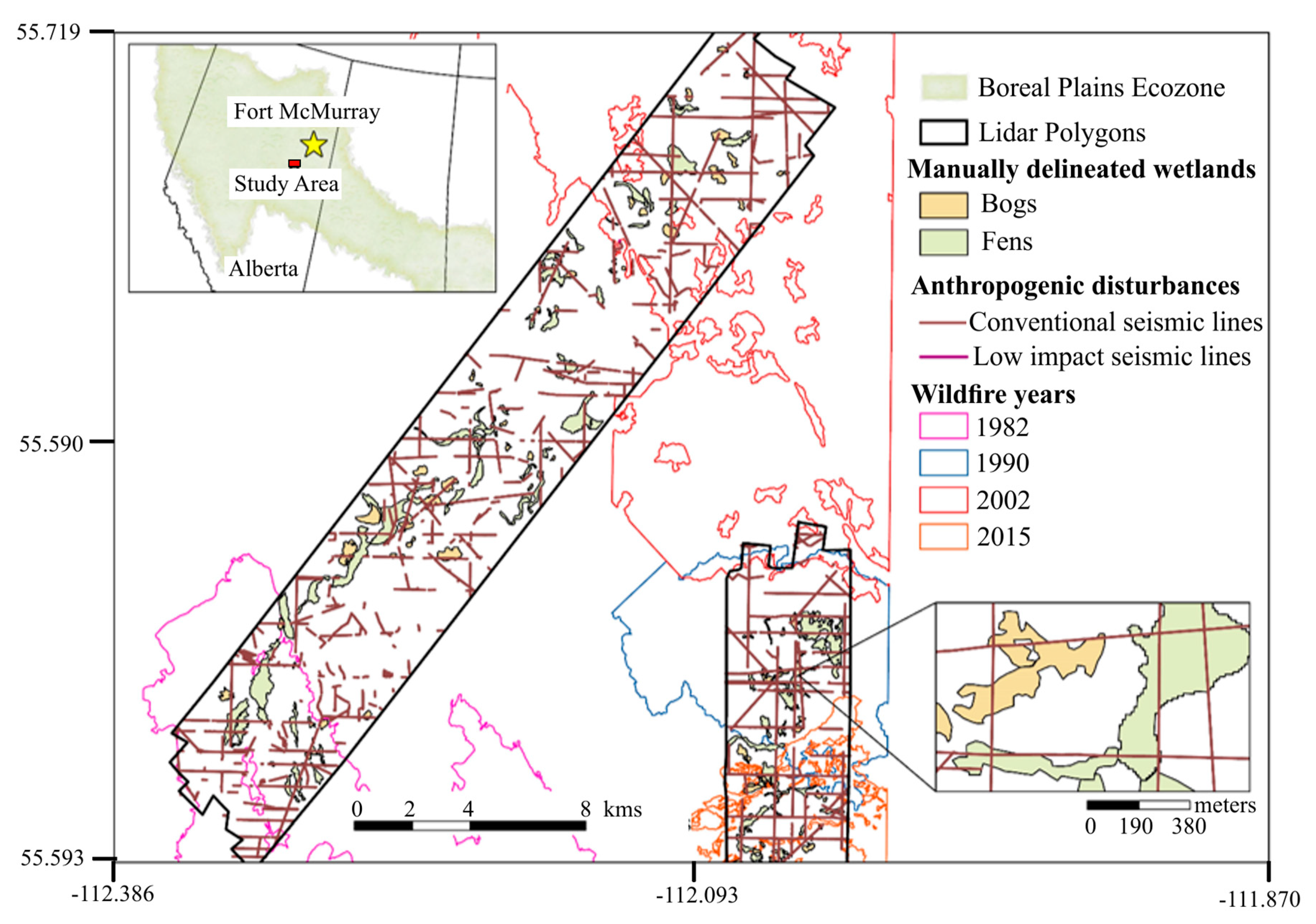
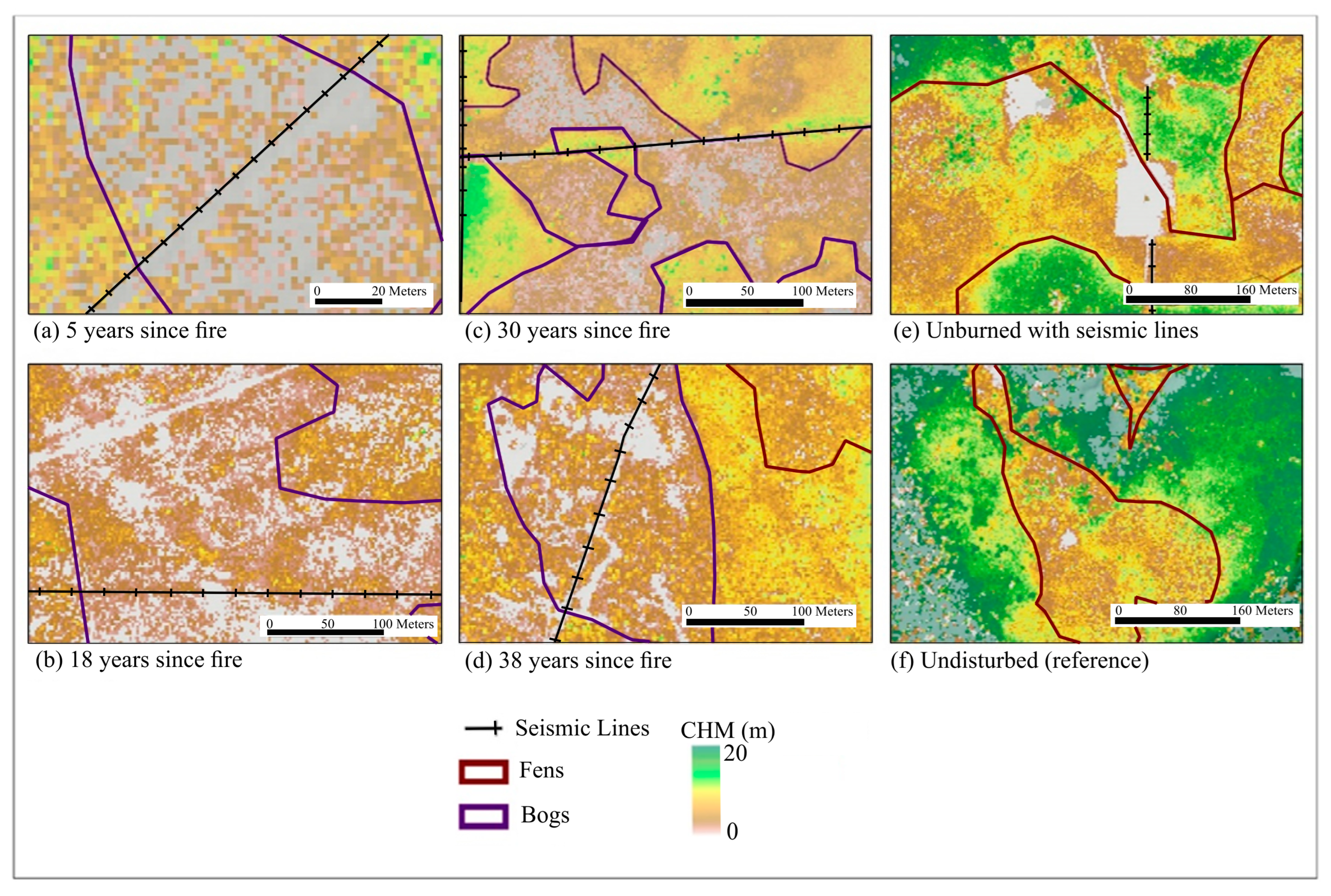
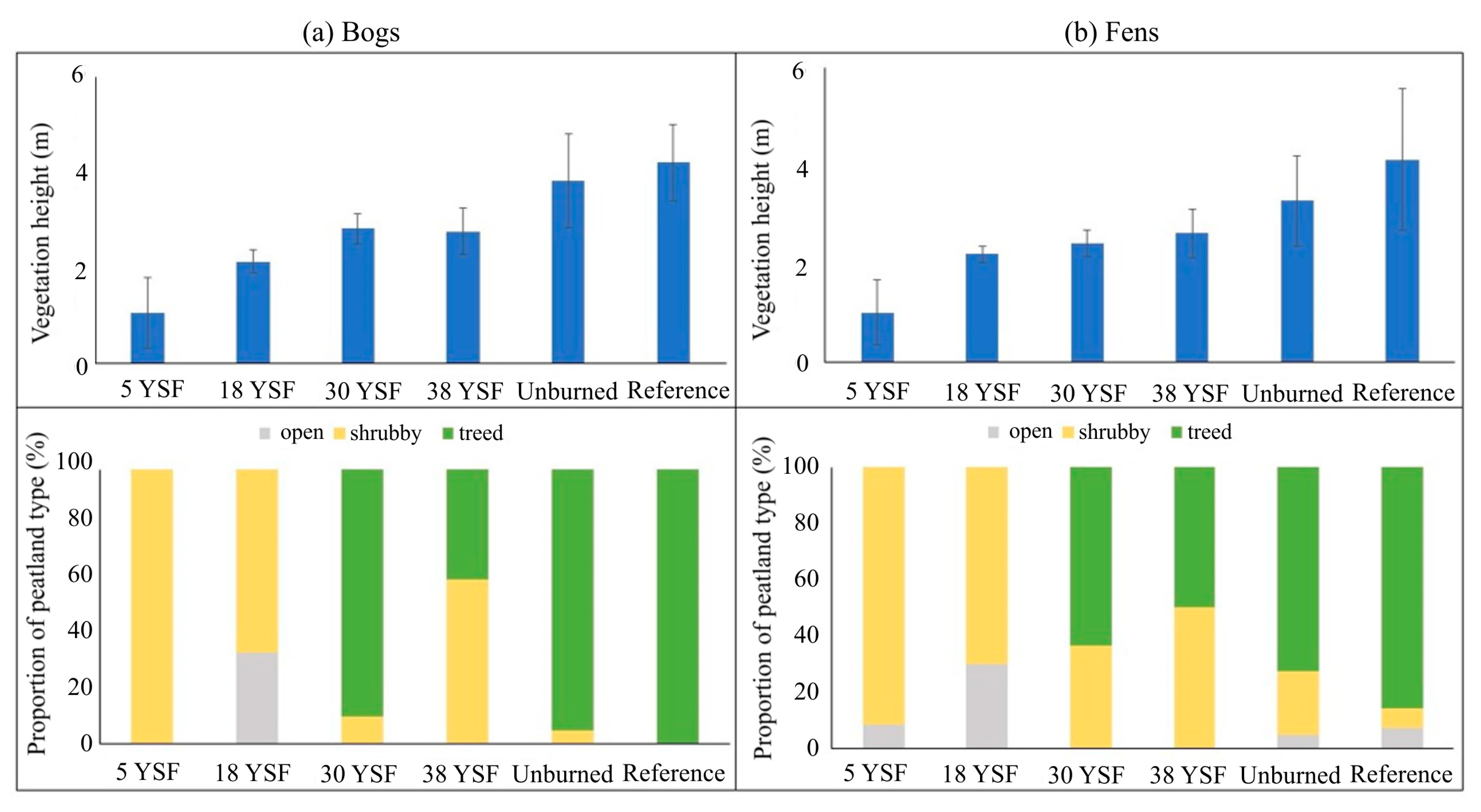
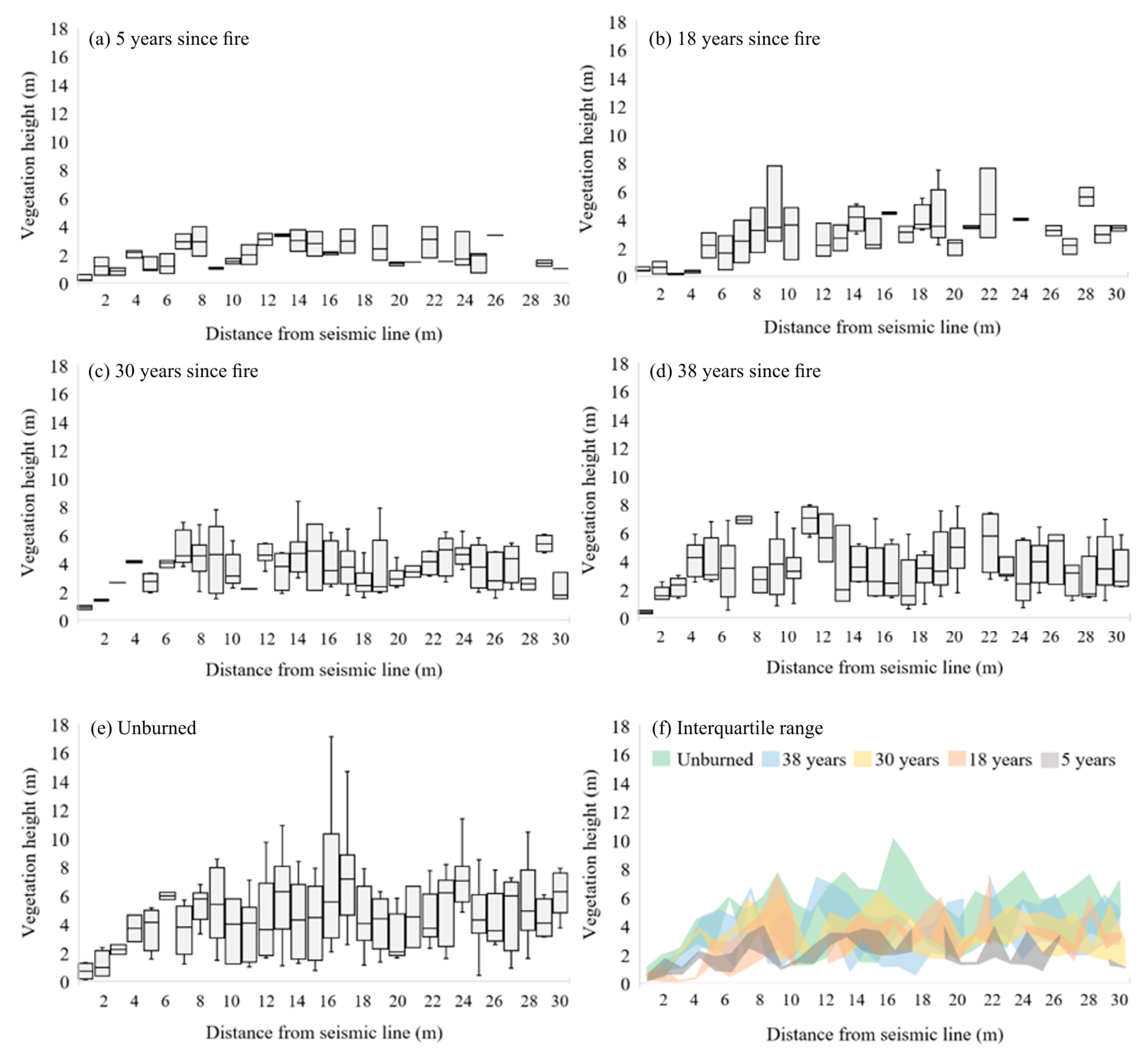

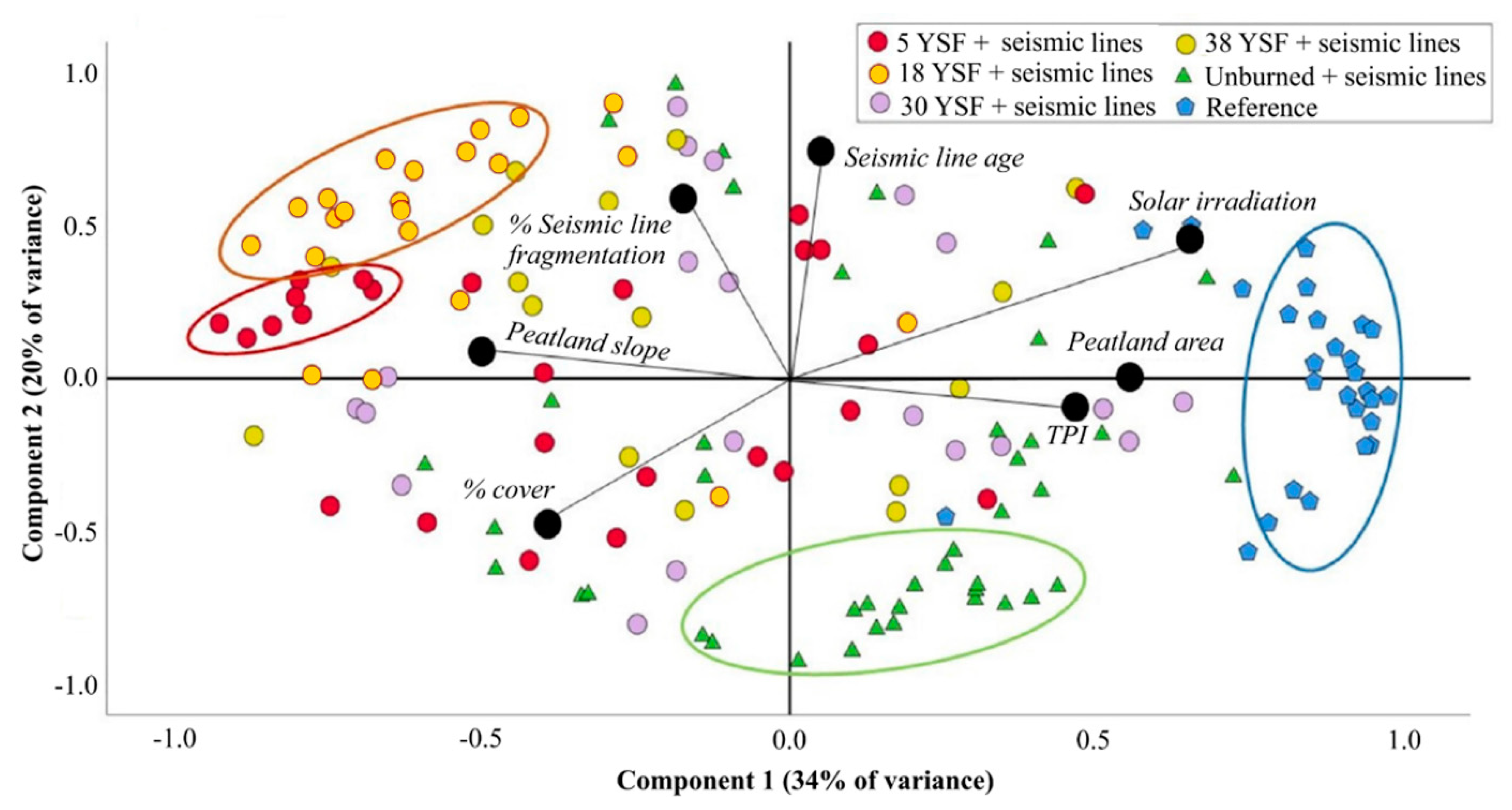
| Variable | Description | Mechanism/Hypothesis | Range of Predictor Variable | Refer- Ences | |
|---|---|---|---|---|---|
| Bogs | Fens | ||||
| TPI (m) | Topographic position index (TPI) from a 2 m DEM by applying a circular search radius: low-lying areas = negative values; upraised = positive values; values near 0 are flat | Negative TPI may be an indicator that the ground surface is closer to the top of the water table, which may result in less woody vegetation recovery. | −1.3 to 0.7 m | −5.6 to 1.7 m | [4,49] |
| Peatland slope (degrees) | Average peatland slope calculated using DEM | Peatlands with greater sloped surfaces might have a greater growth rate/more tree establishment since fire due to enhanced drainage and overall drier soils. | 0.3 to 4.1° | 0.4 to 7.1° | [46,50] |
| Peatland area (m2) | Peatland area in m2 determined from the peatland manual delineation | Smaller peatlands are more vulnerable to disturbance due to proximity to uplands, resulting in greater post-disturbance deciduous shrub growth. | 2539 to 292,148 m2 | 5979 to 137,549 m2 | [45,51] |
| Solar radiation (Wh m−2) | Incoming solar radiation determined from 2 m DSM of tree heights + elevation over a period of one year | South-facing areas and areas adjacent to seismic lines receive more incoming solar radiation compared with north-facing and forested areas, enhancing growth | 987 to 3466 Wh m−2 | 718 to 3372 Wh m−2 | [17,20,37,41] |
| Percent cover (%) | Percent cover of trees and shrubs generated using all returns above 0.5 m from all channels | Low percent cover is an indicator of open canopies and short vegetation, mosses ≤ 0.5 m, compared with peatlands with higher percent vegetation cover. | 11 to 91% | 14 to 92% | [22,25,52] |
| Seismic line age (years) | Age of seismic line in years, calculated by subtracting the year the line was installed from the year the lidar data were collected | Taller vegetation found within and adjacent to older seismic lines may be more likely, as these have more time for woody vegetation to establish compared with more recently developed seismic lines with early vegetation succession. | 0 to 37 years | 0 to 37 years | [16,35,41,52] |
| Human- caused peatland fragment- ation (%) | Percentage of fragmented peatland area (seismic lines, well pads, trails, and pipelines (from HFI)) | More fragmented peatlands will have less vegetation recovery as they are flatter and closer to the water table. | 0 to 16.0% | 0 to 10.5% | [16,19,23,24] |
| Bog/Fen Area (m2) | Seismic Line Age (years) | % Area Seismic Lines | TPI | Peatland Slope | Irradiance (Wh m−2) | % Cover | |
|---|---|---|---|---|---|---|---|
| Bog/fen area (m2) | 1.00 | - | - | - | - | - | - |
| Seismic line age | 0.05 | 1.00 | - | - | - | - | - |
| % area seismic lines | −0.11 | 0.27 | 1.00 | - | - | - | - |
| TPI | 0.17 | 0.05 | −0.04 | 1.00 | - | - | - |
| Peatland slope | −0.21 | 0.06 | −0.01 | −0.24 | 1.00 | - | - |
| Irradiance (Wh m−2) | 0.29 | 0.25 | 0.02 | 0.21 | −0.38 | 1.00 | - |
| % cover | −0.19 | −0.34 | −0.07 | −0.10 | 0.20 | −0.67 | 1.00 |
Disclaimer/Publisher’s Note: The statements, opinions and data contained in all publications are solely those of the individual author(s) and contributor(s) and not of MDPI and/or the editor(s). MDPI and/or the editor(s) disclaim responsibility for any injury to people or property resulting from any ideas, methods, instructions or products referred to in the content. |
© 2023 by the authors. Licensee MDPI, Basel, Switzerland. This article is an open access article distributed under the terms and conditions of the Creative Commons Attribution (CC BY) license (https://creativecommons.org/licenses/by/4.0/).
Share and Cite
Enayetullah, H.; Chasmer, L.; Hopkinson, C.; Thompson, D.; Cobbaert, D. Examining Drivers of Post-Fire Seismic Line Ecotone Regeneration in a Boreal Peatland Environment. Forests 2023, 14, 1979. https://doi.org/10.3390/f14101979
Enayetullah H, Chasmer L, Hopkinson C, Thompson D, Cobbaert D. Examining Drivers of Post-Fire Seismic Line Ecotone Regeneration in a Boreal Peatland Environment. Forests. 2023; 14(10):1979. https://doi.org/10.3390/f14101979
Chicago/Turabian StyleEnayetullah, Humaira, Laura Chasmer, Chris Hopkinson, Daniel Thompson, and Danielle Cobbaert. 2023. "Examining Drivers of Post-Fire Seismic Line Ecotone Regeneration in a Boreal Peatland Environment" Forests 14, no. 10: 1979. https://doi.org/10.3390/f14101979
APA StyleEnayetullah, H., Chasmer, L., Hopkinson, C., Thompson, D., & Cobbaert, D. (2023). Examining Drivers of Post-Fire Seismic Line Ecotone Regeneration in a Boreal Peatland Environment. Forests, 14(10), 1979. https://doi.org/10.3390/f14101979







